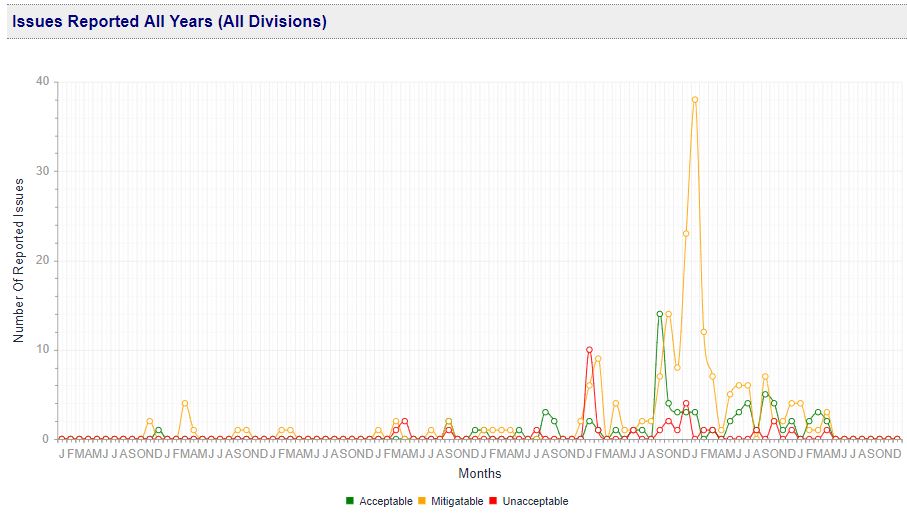Benefits of Showing Employees That Your SMS Is Effective

Showing employees that your SMS is effective is simply building your case for the SMS. That being said, there are several prerequisites for being able to show employees that your SMS is effective:
- Your SMS has actually demonstrated safety improvement;
- Employees are actually reporting issues;
- Your SMS has a good or improving reputation in the company; and
- Risk controls are actually improving risk in the operational environment.
If your safety management system cannot demonstrate most or all of these points, then you cannot show that your SMS is effective.
If you can show that your SMS is effective, then you have an extremely powerful tool for:
- Selling skeptical employees on the benefits of participating;
- Generating inclusion in the SMS through showing the “popularity” of the safety program;
- Getting more budget (if applicable);
- Getting even more participation in safety;
- More efficient SMS induction when onboarding new employees; and
- Improving Norms and other aspects of Safety Culture.
How to Build Your Case for Effectiveness of SMS
As said, you simply need to build your case for effectiveness. You always have to keep in mind that when you are building your case, you are:
- Speaking to individual employees; and NOT
- Some generic, company-wide specter.
This is an important point because it means that you need to build your case for the SMS-based things that every employee will care about: namely, how does their involvement affect their own safety? There are 4 steps to building your case, in this order:
- Show an increase in reported issues over time (or at the very least, a consistent number of reports);
- Show increase in perception of SMS (via safety surveys);
- Show a decrease in the average risk of reported issues; and
- Show a decrease in the number of injuries, serious and/or minor.
What you are communicating to them with these steps is that:
- Their involvement in the SMS has made the environment safer; and
- Their support of the SMS has made their own life safer.
Related Articles on Employee Safety Performance
- 7 Charts to Monitor Employee Safety Performance in SMS
- 4 Tips to Monitor Employee Safety Performance in Aviation SMS
- How to Improve Aviation SMS Performance Monitoring Activities
1 - Show Number of Reported Issues Over Time

Step one is to show a chart of reported issues. Your chart should show:
- Ideally, a steady increase in reported issues over time, or
- For well-implemented SMS, a steady number of reports over time.
Without this chart, it’s hard to make a case for the effectiveness of your SMS. You need to show that employees are participating. Otherwise, it simply sends the message that safety is being improved for other reasons besides the individual employee’s involvement.
Related Articles on Employees Reporting
- What Issues Employees Should Be Reporting in Your SMS
- 5 Simple Tips to Improve Aviation Safety Reporting Cultures
- How to Get Employees Participating in Safety Reporting - Aviation SMS
2 - Show Data on Safety Surveys Over Time

This data isn’t entirely necessary, but it is a powerful way to show that SMS is growing in popularity. Ideally, you will have a chart showing an increase over time in survey questions regarding employee positive regard for the SMS.
Most people care not so much about what their peers think right now but in the trends. Showing a trend of the popularity of your SMS is a great way to give employees pause and reconsider any misgivings they might have about the safety program.
Furthermore, an increase in popularity only further justifies your case that individual employee involvement in the SMS has a direct benefit on safety.
Necessarily, being able to show this chart entails that:
- You have been consistently performing safety surveys;
- Your safety surveys have been using the same questions over time; and
- The survey answers are quantifiable.
Surveys with explanation-based answers (such as “fill in the blank”) will not allow you to create a chart.
Related Articles on Aviation SMS Safety Survey
- 30 Good Questions for Safety Surveys in Aviation SMS
- How to Use Safety Surveys to Improve Safety Culture in Aviation SMS
- Aviation SMS Surveys - Most Neglected Safety Promotion Tool
3 - Show Metrics on Average Severity of Reported Issues

Having a chart showing the percentage of reported issues over time based on risk level (data comes from initial risk assessment) is without question the most effective way to show the level of exposure in your operational environment over time.
Consider the example:
- January 2017:
- Green/acceptable issues: 68%
- Yellow/mitigatable issues: 26%
- Red/Unacceptable issues: 6%
- January 2018:
- Green/acceptable issues: 78%
- Yellow/mitigatable issues: 21%
- Red/Unacceptable issues: 1%
If you can show a chart that demonstrates numbers with improving Green issues, and decreasing yellow and/or red issues, then you easily prove that employee participation is making their workplace safer to operate in.
4 - Show Metrics on Workplace Injuries or Other Key Safety Data
Finally, ultimately what each employee cares about is his/her own personal safety. Showing increased workplace safety is good, but also being able to show increased personal safety is the real seller.
Ideally, you would have a chart that shows:
- Decreased lost-time injury;
- Decreased injuries requiring hospitalization; and
- Decreased minor injuries (though if you show decreased severe injuries, this might not be necessary).
You might even supplement this chart with an actual story from one of your employees showing a situation where the SMS helped them operate safely where they would have otherwise been injured.
Obviously, not all service operators have departments that are inherently dangerous in terms of bodily harm. In these situations, you may substitute other key safety charts, such as:
- Reduced safety issues from fatigue;
- Reduced safety issues from miscommunication;
- Fewer work days missed due to sickness/illness;
- And so on.
The point is simply to demonstrate how SMS improves an individual’s life in the workplace.
Last updated October 2025.







